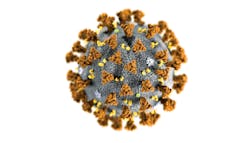How is your SPD “quaranteam” faring amidst COVID-19?
Media traced the novel coronavirus, known as COVID-19, to an outbreak that reportedly stemmed from a market in Wuhan, China in December 2019. Where were you when you heard about it? What was your reaction? I, like many others, thought, “oh no, look what is happening in China!” As we followed the news and watched people with the virus being forcefully pulled from their homes, we never thought the U.S., let alone the rest of the world, would be dealing with the virus and all of the disruption it has caused in our lives.
During the next few months, the speed at which the virus spread seemed like a tsunami pounding the coastline so quickly that we were unable to prepare for the rapidly rising floodwaters. How is the virus spread? How long does it last? How do we test for it? What kind of personal protective equipment (PPE) do we need? Do we need a different type of cleaner and detergent? What does the Environmental Protection Agency (EPA) suggest?
What happens when we do not have all – or as many of – the facts? Oftentimes we panic and begin buying and hoarding everything from PPE to cleaners/detergents to household items just to make sure we are not caught before any shortage emerges.
Experts from the Food and Drug Administration (FDA), Centers for Disease Control and Prevention (CDC), World Health Organization (WHO), Occupational Safety and Health Administration (OSHA) and the Department of Homeland Security, among others, have access and permission to release supplies in the national stockpile. The staff with direct patient contact were most afraid of not knowing whether they would contract the virus and how it would impact their lives. Those of us who support the frontline staff wanted to ensure we were doing everything we could to stop the spread of the virus to our colleagues, patients and families.
Questions abound
Some of the questions raised in SPD involved PPE: Do we need to wear N95 masks? The answer was no. Save them for the staff making direct patient contact. How often do we need to change attire? Same as always. Do I need to be notified if equipment returned is from a COVID-19 patient? No, we need to follow universal precautions. Do we need to use different cleaning agents and detergents? The manager should validate the cleaners/detergents in use kill viruses like the flu, chickenpox, Hepatitis B and C and HIV.
This downtime due to the reduced number of procedures provided many opportunities to update the department policies, etc. This was a great time to ensure your Instructions for Use (IFU) for products are up to date. Are you following the IFUs? Do you have the correct tools to clean, such as brushes, and appropriate packaging for the items? This was a great opportunity to take the time to clean the department, look for outdated supplies, update the PAR lists and acquire appropriate items to ensure the IFUs are being followed. Verify the department has a copy of each of the IAHCSMM, AAMI ST79 and TIR 68 manuals and that your policies and procedures follow the guidelines. This is also an important time for staff to engage in performing these types of assignments for which they do not normally get involved. This includes training and education on how the epidemic was felt, what changes occurred, what steps should have been taken earlier, how the information was acquired? All represent an opportunity to fill time as procedural cases are down and support preparedness for the next disaster that occurs.
There are positive ramifications in all of this. It has brought together all departments within organizations to have conversations about who does what – in detail – understanding how any changes in use of approved cleaning products, protocols, use of non-FDA-approved/cleared products, such as masks, proper use and reuse of PPE, and acquiring PPE masks from many vendors/lay people who are making masks that may not be FDA-approved/cleared. Do we accept this? And what functions are allowed to use these products – SPD or frontline staff? These decisions are made collaboratively. The importance of every role in the organization has now been highlighted. The team effort and the support from each department should improve future communications as long as we all continue to understand the different perspectives and needs by function and respect them.
About the Author

Jean Sargent
Jean Sargent, CMRP, FAHRMM, FCS, currently serves as Principal, Sargent Healthcare Strategies, and is a member of Healthcare Purchasing News’ Editorial Advisory Board. She can be reached at [email protected].
